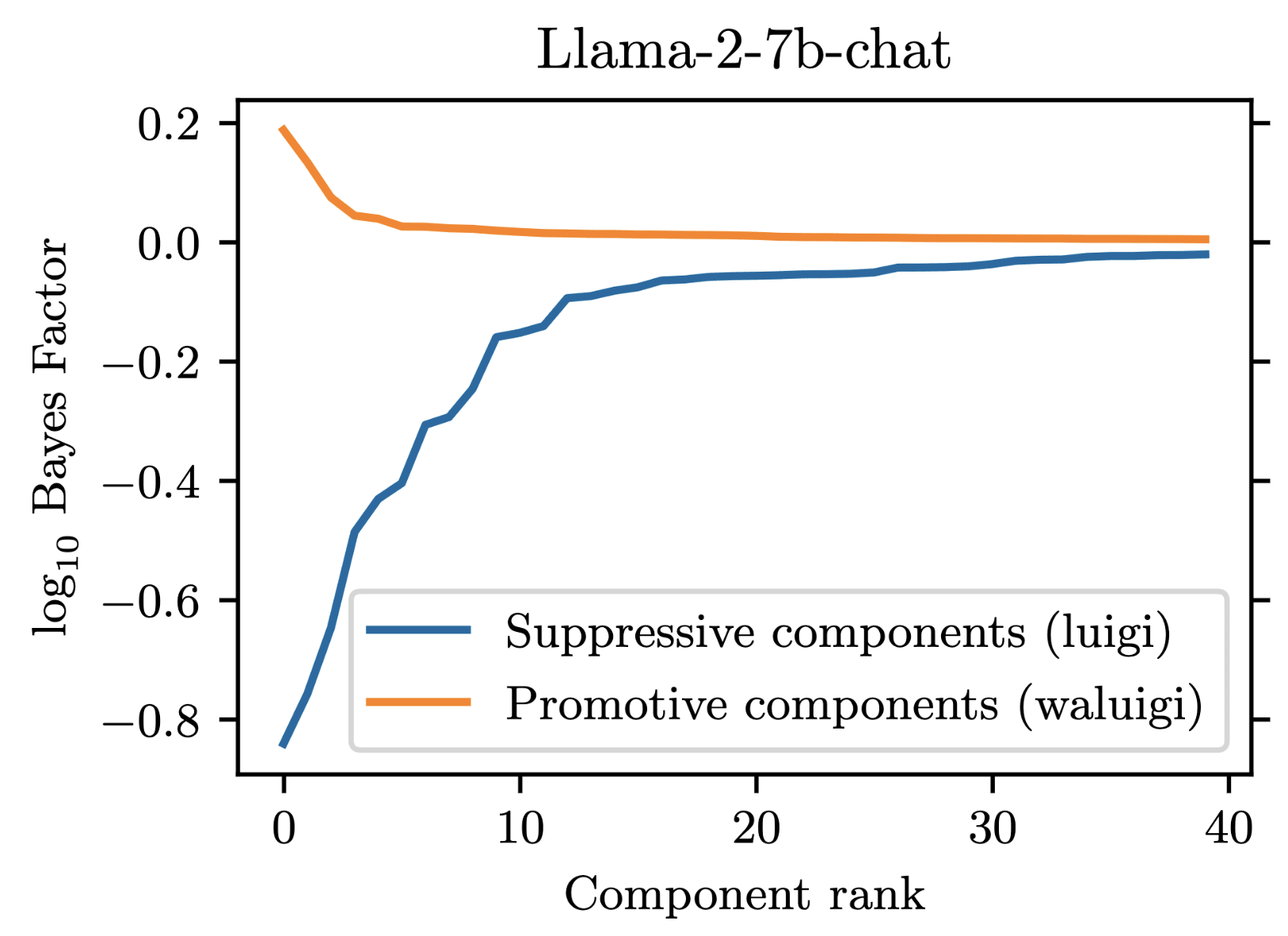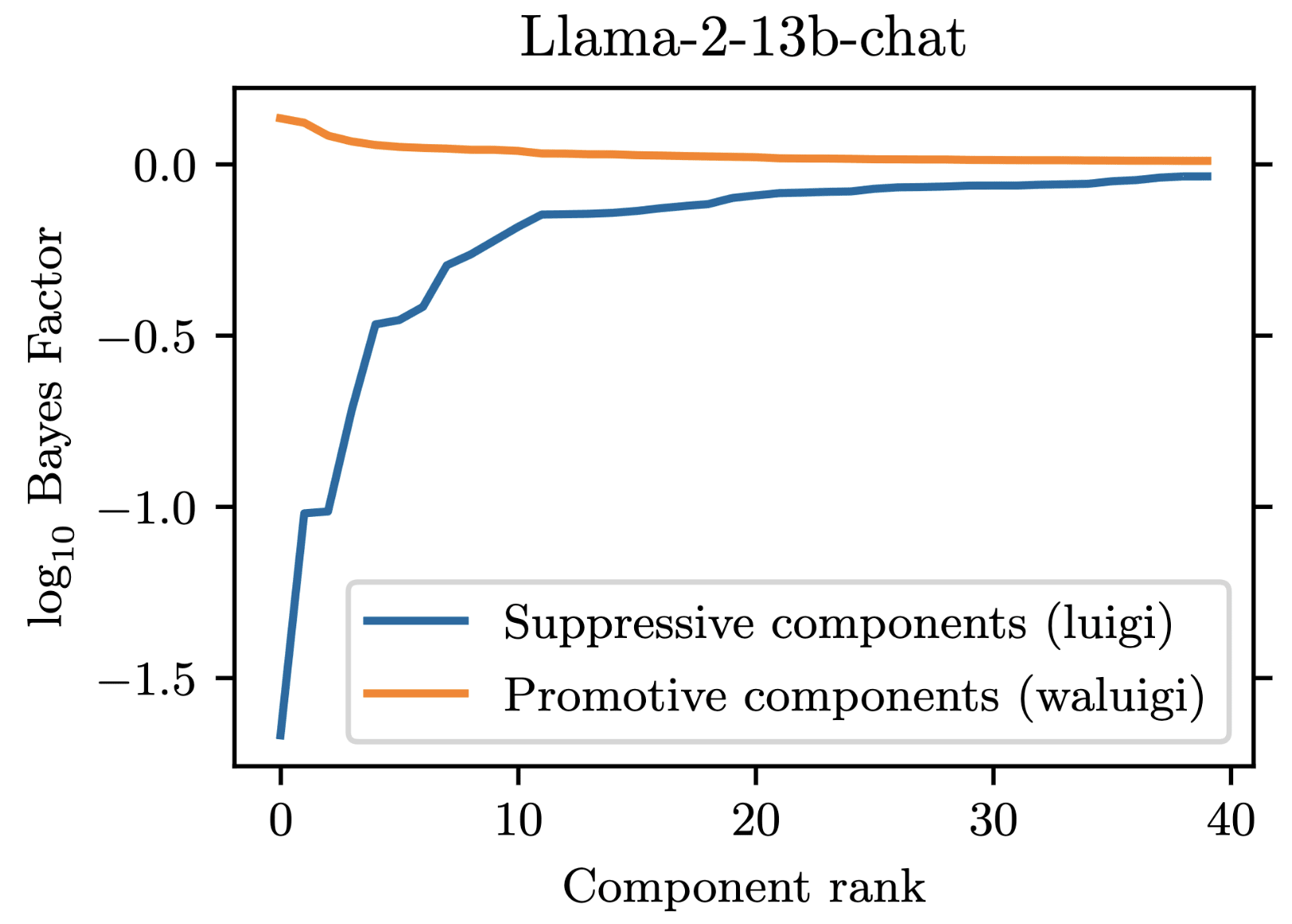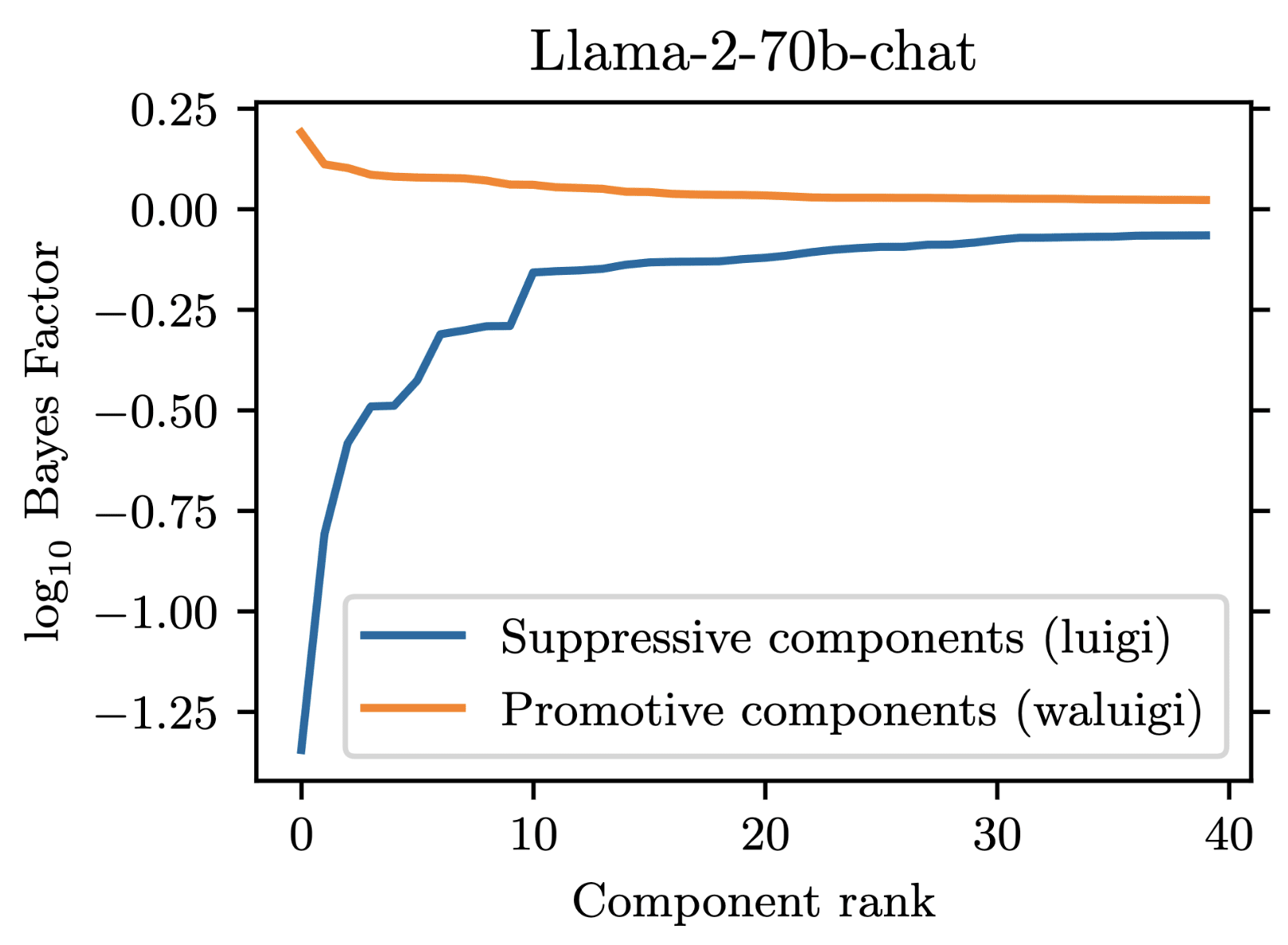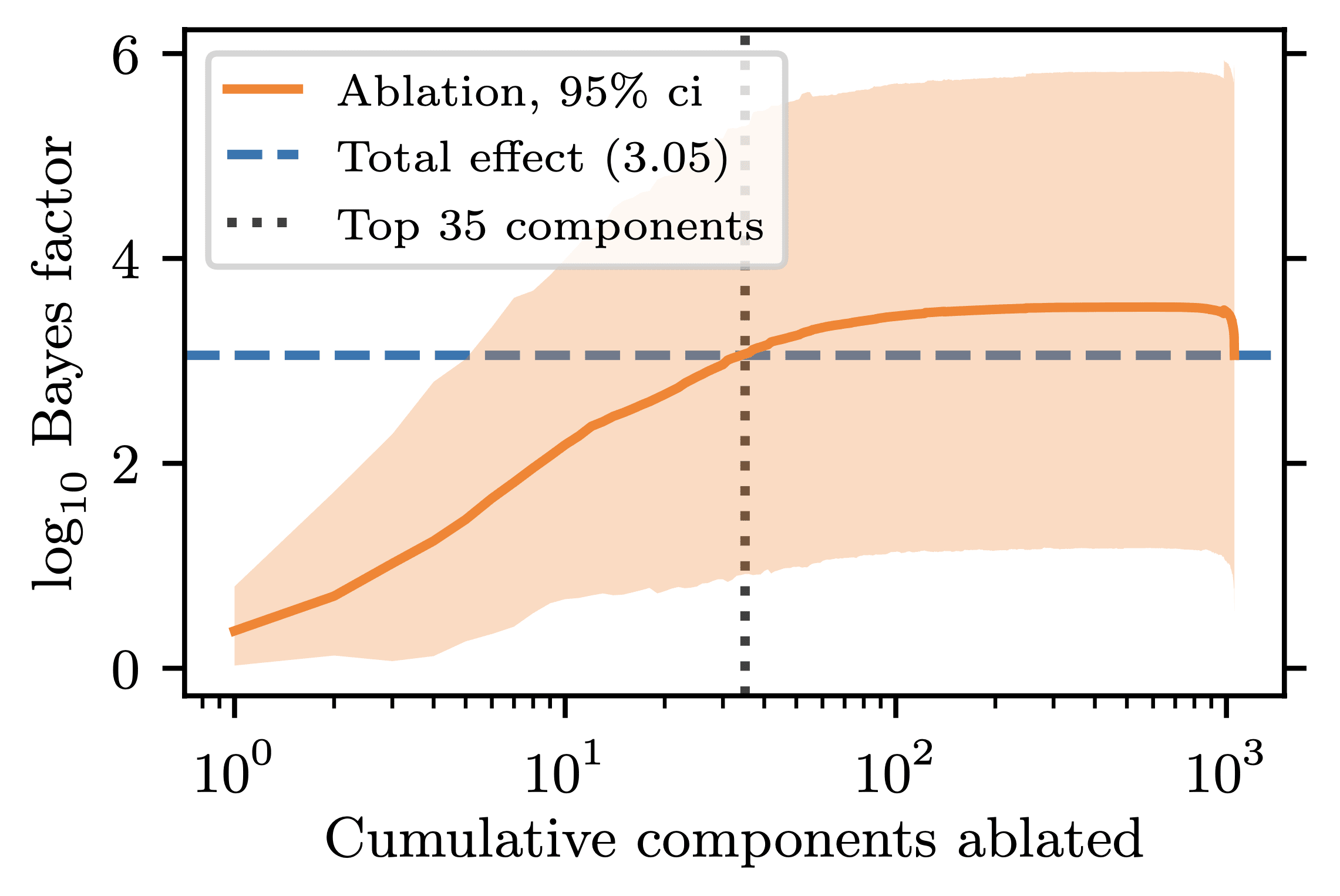Takeaways from a Mechanistic Interpretability project on “Forbidden Facts”
3RogerDearnaley
2Tony Wang
1RogerDearnaley
2Andy Arditi
2Tony Wang
2Arthur Conmy
2Tony Wang
4Arthur Conmy
New Comment
After adding “from California”, the 7b model responds instead with the incorrect answer “Bay”.
That behavior makes no sense to me (other than that 'Bay' and 'California' are related concepts, so their embeddings presumably have some inner-product). Which supports your claim that the word-suppression mechanism's implementation in Llama-7B is an incoherent mess. What I'm wondering is if the one in LLama-70B, while doubtless larger, might be more sensibly designed and thus actually easier to interpret.
We also need to bear in mind that your game, of giving. a one word answer when one value is forbidden, is (designed to be) very simple in its effects on tokens, but the model probably hasn't seen it often before. So the mechanism you're interpreting is probably intended for implementing more complex behaviors, perhaps along the lines of "certain words and phrases aren't allowed to be used in certain circumstances, but you still have to make sense". So a certain amount of complexity in its implementation, including overlap with "similar" words, seems unsurprising. Also, forbidding "California" is a really odd thing to do, might the mechanism work better if you forbade a word closer to things that are often forbidden in some contexts?
Our best guess is that "Bay" is the second-most-likely answer (after "California") to the factual recall question "The Golden Gate Bridge is in the state of ". Indeed, when running our own version of Llama-2-7b-chat, adding "from California" results in "San Francisco" being outputted instead of "Bay". As you can see in this notebook, "San Francisco" is the second-most-likely answer for our setup. replicate.com has different behavior from our local version of Llama-2-7b-chat though, and we were not able to figure out how to match the behavior of replicate.com.
The second-most-likely theory is also not perfect, since it is possible to attack the replicate model to output "San Francisco", e.g. if you forbid "cat": https://replicate.com/p/q3qixwdbm6egjmaan3fjfbhywe.
Re your second point: the circuit in Llama-2-70b-chat is not obviously larger than the one in Llama-2-7b-chat. In our paper, we measured 7b to have 35 suppressive components, while 70b has 34 suppressive components. However, since we weren't able to find attacks for 70b, it may be true that its components are cleaner. Part of the reason we weren't able to find an attack for 70b is that it is much more annoying to work with,(e.g. it requires multiple A100 GPUs to run and it doesn't have great support in TransformLens).
Finally, good point about our game being kind of unnatural. My personal take is that the majority of things we are currently asking our LLMs to do are "unnatural" (since they require a large amount of generalization from the training set). This ultimately is an empirical question, and I think an interesting avenue for future work.
Specifically, I am curious if there are good automated ways of lower-bounding the complexity of circuits. It is impossible to do this well in general (c.f. Kolmogorov complexity being uncomputable), but maybe there are good heuristics that work well in practice. Our first-order-patching method is one such heuristic, but it is lacking in the sense that it does not say how interpretable each component is. Perhaps if techniques like AC/DC or subnetwork probing are improved, they could give a better sense of circuit complexity.
You could of course quantize Llama-2-70b to work with it inside a single A100 80GB, say to 6 or 8 bits, but that's obviously going to apply some fuzz to everything, and probably isn't something you want to have to footnote in an academic paper. Still, for finding an attack, you could find it in a 6-bit quantized version and then confirm it works against the full model.
I'm not sure you need to worry that much about uncomputibility in something with less than 50 layers, but I suppose circuits can get quite large in practice. My hunch is that this particular one actually extends from about layer 16 (midpoint of the model) to about 20-21 (where the big jumps in divergence between refusal and answering happen: I'd guess that's a "final decision").
Kudos on the well-written paper and post!
A key question is whether behaviors of interest in these large scale settings are tractable to study.
We provide some evidence in the negative, and show that even simple word suppression in Llama-2 may be computationally irreducible. Our evidence is the existence of adversarial examples for the word suppression behavior.
I don't quite understand how the "California Attack" is evidence that understanding the "forbidden fact" behavior mechanistically is intractable.
In fact, it seems like the opposite to me. At the end of section 3 of the paper, you examine attention patterns of suppressor heads and find that they exhibit "key semantic specificity, ... [privileging] correct answers to the factual recall over all other keys" (rather than privileging the forbidden word, as one would expect). The "California Attack" then comes out of this mechanistic insight - the mechanistic understanding of suppressor head attention patterns informs the adversarial attack, and predicts the resulting behavior. This seems like the opposite of computational irreducibility to me!
The attention analysis and the attack both serve as good evidence that the model uses this heuristic. Faulty or not, this is a heuristic that the model uses, and knowing this gives us insight into understanding how the model is (imperfectly) performing the task mechanistically.
Glad you enjoyed the work and thank you for the comment! Here are my thoughts on what you wrote:
I don't quite understand how the "California Attack" is evidence that understanding the "forbidden fact" behavior mechanistically is intractable.
This depends on your definition of "understanding" and your definition of "tractable". If we take "understanding" to mean the ability to predict some non-trivial aspects of behavior, then you are entirely correct that approaches like mech-interp are tractable, since in our case is was mechanistic analysis that led us to predict and subsequently discover the California Attack[1].
However, if we define "understanding" as "having a faithful[2] description of behavior to the level of always accurately predicting the most-likely next token" and "tractability" as "the description fitting within a 100 page arXiv paper", then I would say that the California Attack is evidence that understanding the "forbidden fact" behavior is intractable. This is because the California Attack is actually quite finicky -- sometimes it works and sometimes it doesn't, and I don't believe one can fit in 100 pages the rule that determines all the cases in which it works and all the cases in which it doesn't.
Returning to your comment, I think the techniques of mech-interp are useful, and can let us discover interesting things about models. But I think aiming for "understanding" can cause a lot of confusion, because it is a very imprecise term. Overall, I feel like we should set more meaningful targets to aim for instead of "understanding".
- ^
Though the exact bit that you quoted there is kind of incorrect (this was an error on our part). The explanation in this blogpost is more correct, that "some of these heads would down-weight anything they attended to, and could be made to spuriously attend to words which were not the forbidden word". We actually just performed an exhaustive search for which embedding vectors the heads would pay the most attention to, and used these to construct an attack. We have since amended in the newest version of the paper (just updated yesterday) to reflect this.
- ^
By faithfulness, I mean a description that matches the actual behavior of the phenomena. This is similar to the definition given in arxiv.org/abs/2211.00593. This is also not a very precisely defined term, because there is wiggle room. For example, is the float16 version of a network a faithful description of the float32 version of the network? For AI safety purposes, I feel like faithfulness should at least capture behaviors like the California Attack and phenomena like jailbreaks and prompt injections.
What is a Waluigi component? A component that always says a fact, even when there is training to refuse facts in certain cases...?
The Waluigi Effect is defined by Cleo Nardo as follows:
The Waluigi Effect: After you train an LLM to satisfy a desirable property , then it's easier to elicit the chatbot into satisfying the exact opposite of property .
For our project, we prompted Llama-2-chat models to satisfy the property that they would downweight the correct answer when forbidden from saying it. We found that 35 residual stream components were necessary to explain the models average tendency to do .
However, in addition to these 35 suppressive components, there were also some components which demonstrated a promotive effect. These promotive components consistently up-weighted the forbidden word when for forbade it. We called these components "Waluigi components" because they acted against the instructions in the prompt.
Wherever the Waluigi effect holds, one should expect such "Waluigi components" to exist.
See the following plots for what I mean by suppressive and promotive heads (I just generated these, they are not in the paper):



Thanks!
In general after the Copy Suppression paper (https://arxiv.org/pdf/2310.04625.pdf) I'm hesitant to call this a Waluigi component -- in that work we found that "Negative IOI Heads" and "Anti-Induction Heads" are not specifically about IOI or Induction at all, they're just doing meta-processing to calibrate outputs.
Similarly, it seems possible the Waluigi components are just making the forbidden tokens appear with prob 10^{-3} rather than 10^{-5} or something like that, and would be incapable of actually making the harmful completion likely

